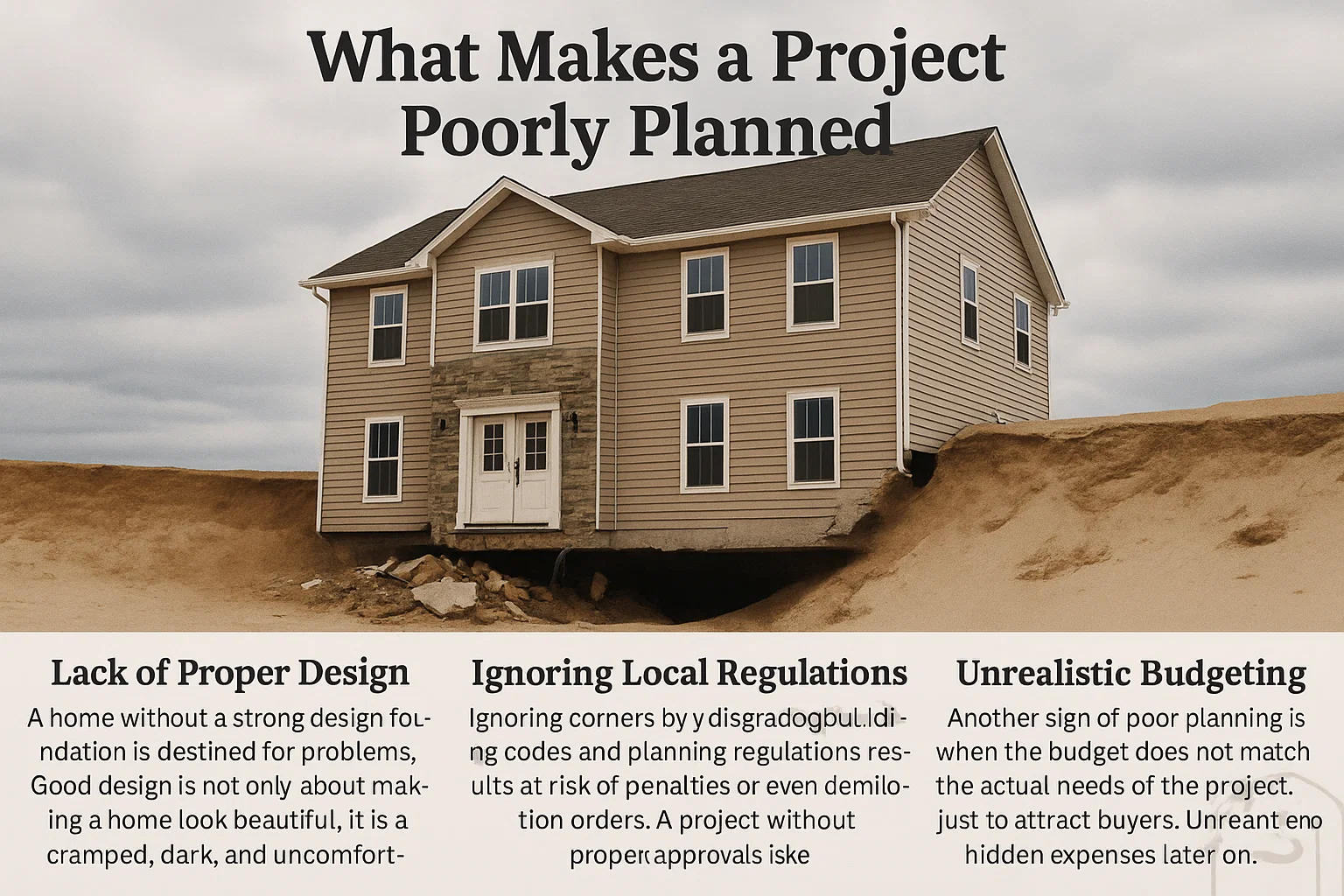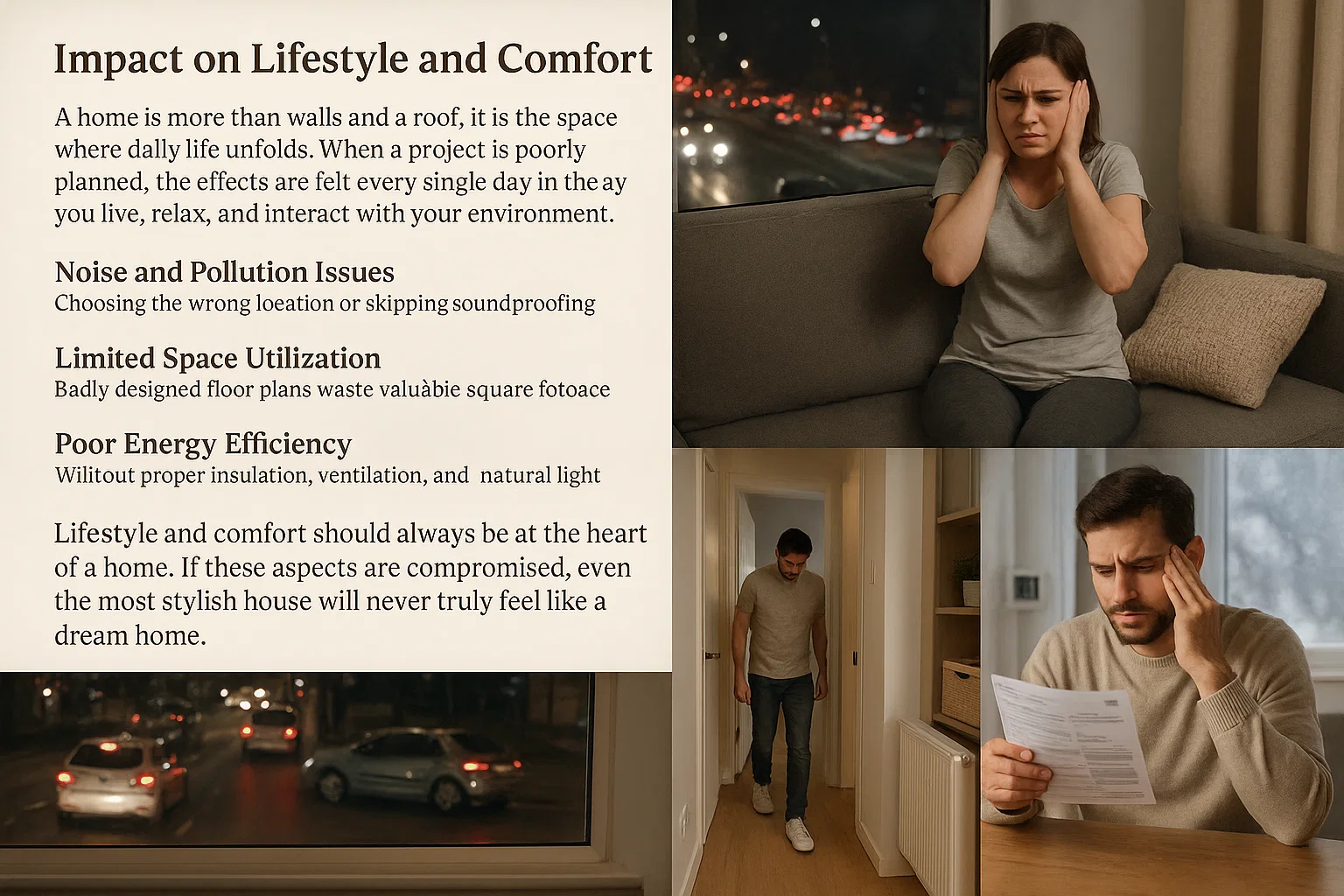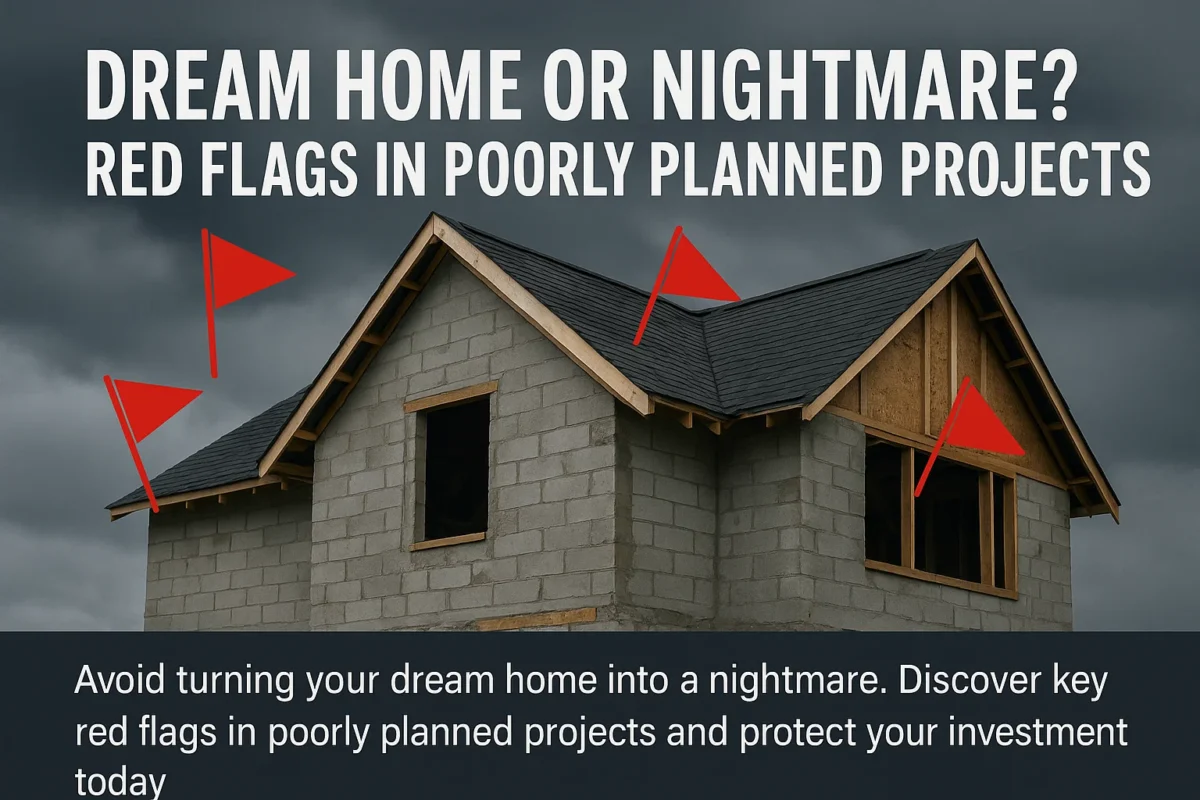Construction, Architecture, House Plans, Real Estate
Dream Home or Nightmare? Worst Red Flags in Poorly Planned Projects
Buying or building a home is one of the most exciting and emotional journeys you can take. It is more than just a property purchase, it is the foundation of your lifestyle, your family’s security, and in many ways, your legacy. For most people, the idea of a dream home carries visions of cozy mornings, peaceful evenings, and the joy of creating lifelong memories within those walls. The thought of owning a space that truly belongs to you brings comfort and pride.
But here is the hard truth. Not every project that promises a dream home actually delivers one. Behind glossy brochures, polished sales pitches, and eye catching designs, there are often hidden dangers that can turn that dream into a long lasting nightmare. Poorly planned projects are more common than many buyers realize, and they bring with them financial burdens, legal complications, and in some cases serious safety risks.
Imagine moving into what you thought was your perfect home only to discover cracks creeping along the walls, water seeping into the basement, or endless unexpected costs piling up every month. Suddenly, instead of enjoying your new beginning, you are consumed by repairs, disputes, and stress. The dream starts to crumble.
This is why identifying the red flags in housing projects before making a decision is absolutely essential. A home is not just about appearances or location, it is about structural integrity, proper planning, legal security, and long term livability. In this article we will uncover the most common warning signs that separate a true dream home from a financial and emotional nightmare, giving you the knowledge you need to make a safe and confident choice.
What Makes a Project Poorly Planned
A poorly planned project is like building a house on sand. It might look good on the surface for a short time, but eventually the flaws show and everything begins to collapse. Many people fall into the trap of believing that a project with attractive finishes or fancy advertisements is automatically reliable. In reality, the most serious problems often start long before construction even begins. Understanding what makes a project poorly planned is the first step to avoiding costly mistakes.

Lack of Proper Design
A home without a strong design foundation is destined for problems. Good design is not only about making a home look beautiful, it is about creating functionality and flow. When rooms are awkwardly positioned, when natural light is ignored, and when ventilation is overlooked, the result is a home that feels cramped, dark, and uncomfortable. A poorly designed home also wastes valuable space that could otherwise be used for storage, relaxation, or living needs. Over time, these flaws affect both comfort and property value.
Ignoring Local Regulations
Every location has its own set of building codes and planning regulations meant to ensure safety and long term durability. When developers cut corners and ignore these rules, buyers are left with a property that is at constant risk of penalties or even demolition orders. A project without proper approvals is like buying a car without an engine. It might look good on the outside but it will never truly work the way it should.
Unrealistic Budgeting
Another sign of poor planning is when the budget does not match the actual needs of the project. Developers sometimes promise luxury features at unbelievably low prices just to attract buyers. In reality, this often leads to cost cutting during construction, use of substandard materials, and unfinished work. When the budget is unrealistic, buyers end up paying much more in repairs and hidden expenses later on. A well planned project always has a transparent budget that reflects both quality and durability.
Common Red Flags in Housing Projects
When you are in the process of choosing a home, it is easy to be swept away by glossy brochures, elegant model houses, and smooth promises from sales representatives. Yet behind the surface charm, there are warning signs that reveal whether a project is truly worth your investment. These red flags may appear small at first, but if ignored, they can grow into major financial, legal, and safety issues. Knowing what to look out for before signing any documents will protect you from heartbreak later.
Insufficient Planning Permissions
One of the first red flags is when a project lacks the necessary approvals from local authorities. Every construction must follow strict zoning laws, building codes, and environmental guidelines. If the developer cannot provide evidence of valid permits, you may end up facing endless legal battles, heavy fines, or even the risk of the property being declared illegal. Always ask for documentation and confirm it with the relevant authorities before moving forward.
Poor Quality Materials
A home built with cheap or unsuitable materials is like a ticking time bomb. You may not see the flaws immediately, but cracks in the walls, uneven flooring, or doors that refuse to shut properly will reveal themselves soon enough. Inferior materials compromise safety and drastically shorten the lifespan of the home. What seems like a bargain in the beginning often results in high repair and maintenance costs down the road.
Hidden Costs and Surprises
Another common trap in poorly planned projects is the sudden appearance of unexpected expenses. At first, the price may look attractive, but later you may be asked to pay extra for parking spaces, utility connections, landscaping, or maintenance fees that were never clearly stated in the contract. These hidden charges inflate the overall cost of the property and put a strain on your finances. A trustworthy developer will always provide a transparent cost breakdown from the start.
Unqualified Contractors
The skill and experience of the contractor directly influence the quality of your home. When developers hire untrained or inexperienced builders to save money, the results are sloppy and unsafe. From uneven walls to weak roofing, poor workmanship becomes visible over time and compromises both safety and comfort. Always check whether the contractors are licensed and have a proven record of completing projects successfully.
Unclear Timelines
Time is a critical factor in construction. If the builder cannot commit to a realistic timeline, delays are almost guaranteed. Some projects drag on for years, leaving buyers frustrated and financially drained as they continue paying rent while waiting for completion. A reliable project should always have a clear schedule, with progress updates and penalties for delays included in the contract.
Structural Concerns to Watch For
The structure of a home is its backbone. While finishes and decorations may catch the eye, it is the hidden structural elements that determine whether a house will stand the test of time or crumble under pressure. Unfortunately, poorly planned projects often neglect these critical details in an attempt to save money or rush completion. Buyers who fail to recognize these issues early often face endless repairs, safety risks, and a steep drop in property value. Understanding the most common structural concerns is essential before committing to any purchase.
Weak Foundations
The foundation is the most important part of any building. If it is not properly designed and constructed, the entire house is at risk. Weak foundations can cause cracks in walls, sloping floors, and in extreme cases total collapse. Signs of a weak foundation include uneven flooring, gaps between walls and ceilings, and doors or windows that no longer close smoothly. Once foundation problems start, they are incredibly expensive to repair, often costing more than the home is worth. This is why inspecting the base structure before purchase is crucial.
Poor Drainage Systems
Water is one of the biggest threats to any building. A poorly designed drainage system allows rainwater and groundwater to accumulate around the property, leading to dampness, mold growth, and structural weakening over time. Water pooling around the foundation can also cause soil erosion, which destabilizes the base of the home. Inside the house, bad drainage often results in leaks, musty odors, and damage to walls and flooring. Proper drainage should always be part of the initial design, not an afterthought.
Faulty Electrical and Plumbing Work
While electrical and plumbing systems may seem like secondary details, they directly affect both safety and livability. Poorly installed electrical wiring is a major fire hazard, especially when cheap materials are used or circuits are overloaded. Similarly, bad plumbing can lead to constant leaks, low water pressure, and even flooding inside the home. These problems not only reduce comfort but also create hidden structural damage, such as weakened walls and ceilings. A reliable project will always use certified electricians and plumbers to ensure safety and durability.
Legal and Documentation Issues
When it comes to buying a home, the legal and documentation process is just as important as the construction itself. A house may look perfect on the outside, but if the paperwork is incomplete or unclear, the buyer could end up facing endless disputes and financial losses. Many poorly planned projects ignore legal requirements or deliberately hide important details, leaving unsuspecting buyers exposed to risks that can take years to resolve. Understanding the most common legal and documentation issues will help you avoid costly mistakes and protect your investment.
Unclear Ownership Titles
One of the most serious red flags is when the ownership of the land or property is not clearly documented. Some developers attempt to sell homes built on land that has ongoing disputes, multiple claimants, or unresolved inheritance issues. Others fail to transfer ownership properly, leaving the buyer in a vulnerable position. Without a clean and verifiable title deed, you do not truly own the property, no matter how much money you pay. Before committing to a purchase, it is vital to confirm that the land title is genuine, updated, and registered under the rightful owner.
Incomplete Paperwork
A legitimate real estate transaction requires detailed and transparent paperwork. This includes approved building plans, contracts that outline materials and labor, warranties, and agreements covering maintenance and service charges. In many poorly planned projects, the paperwork is vague, missing, or deliberately confusing. This creates loopholes that developers can exploit, leaving buyers with little legal protection if problems arise. Every detail, from the project timeline to the payment structure, should be clearly written and signed by all parties.
Lack of Insurance
Insurance is often overlooked, yet it plays a crucial role in safeguarding both the homeowner and the property. A project without proper insurance exposes buyers to significant risks if accidents, natural disasters, or construction failures occur. Without coverage, the financial burden of damages or losses falls entirely on the buyer. Responsible developers ensure that both the construction process and the finished property are fully insured, offering peace of mind to the future homeowner.
Financial Traps in Poorly Planned Projects
One of the most frustrating parts of dealing with a poorly planned project is the financial burden it places on the buyer. What often starts as an exciting and affordable dream quickly spirals into a series of unexpected expenses and disappointments. Developers who cut corners or rely on misleading sales tactics set traps that drain your savings and lock you into a home that constantly demands more money. By understanding the most common financial traps, you can protect yourself from investing in a property that only looks good on the surface but empties your wallet in the long run.
Overpromised Returns
Many projects are marketed as once in a lifetime investment opportunities. Sales teams highlight flashy brochures filled with promises of high rental yields or rapidly increasing property values. Unfortunately, these claims are often exaggerated to attract buyers. In reality, the location may not support such growth, demand may be lower than projected, or the property itself may lack the quality to command a premium price. Buyers who rely on these promises without independent research often end up with a property that fails to deliver the financial security they were expecting.
Unexpected Maintenance Costs
At first glance, a new home might appear flawless. The walls are freshly painted, the floors are shiny, and everything seems perfect. However, poorly planned projects often hide deeper problems that only surface after a few months of living in the property. Plumbing issues, leaking roofs, faulty wiring, or structural cracks start to appear, forcing the homeowner to spend large sums on repairs. What seemed like a cost effective purchase quickly becomes a money pit. A truly well planned project factors in durability and quality to minimize long term maintenance costs.
Misleading Price Breakdowns
Another common financial trap comes in the form of unclear pricing structures. Developers may advertise an attractive base price to draw attention, but once the buyer is committed, additional charges suddenly appear. These may include fees for parking spaces, connection to utilities, landscaping, community facilities, or even compulsory membership charges. Buyers who fail to read the fine print or demand a detailed cost breakdown often end up paying far more than they initially agreed to.
Impact on Lifestyle and Comfort
A home is more than walls and a roof, it is the space where daily life unfolds. When a project is poorly planned, the effects are felt every single day in the way you live, relax, and interact with your environment.

Noise and Pollution Issues
Choosing the wrong location or skipping proper soundproofing can make a home unbearable. Constant traffic noise, industrial pollution, or nearby construction can rob you of peace and quiet, turning restful nights into restless ones.
Limited Space Utilization
Badly designed floor plans waste valuable square footage. Narrow hallways, awkwardly shaped rooms, and poorly placed storage areas limit functionality and leave the home feeling smaller than it should.
Poor Energy Efficiency
Without proper insulation, ventilation, and natural light, utility bills rise quickly. Homes that lack energy efficiency are not only expensive to maintain but also uncomfortable during extreme weather.
Lifestyle and comfort should always be at the heart of a home. If these aspects are compromised, even the most stylish house will never truly feel like a dream home.
Safety Concerns in Badly Executed Homes
Safety should always be the foundation of any home, yet poorly planned projects often compromise it in dangerous ways. When safety is ignored, the house becomes a daily risk rather than a secure haven.
Fire Hazards
Improper electrical wiring and the use of substandard materials can easily cause fires. What looks like a simple flickering light or a warm socket may be a sign of a serious threat.
Structural Instability
Weak walls, poorly installed roofs, and shaky staircases put the entire structure at risk. Even minor stress from weather or natural shifts can cause serious damage.
Health Risks from Poor Ventilation
Lack of airflow leads to mold, dampness, and stale air. These conditions increase respiratory problems and lower the overall quality of life.
A dream home should give peace of mind, not daily worry. Paying attention to safety concerns before investing ensures your home remains a place of comfort and protection.
How to Spot Red Flags Before Investing
Spotting red flags early can save you from years of financial and emotional stress. A careful approach before signing any contract ensures that your dream home does not become a nightmare.

Research the Developer
Take time to study the track record of the developer. Look at completed projects, customer satisfaction, and whether deadlines were honored. A good reputation is a strong indicator of reliability.
Seek Independent Inspections
Do not rely only on glossy brochures or promises. Hiring a qualified inspector to assess the property reveals hidden flaws in structure, materials, or utilities before you commit.
Check Customer Reviews and Testimonials
Feedback from previous buyers offers valuable insight. Reviews often reveal problems such as delays, poor communication, or quality issues that the developer might not disclose.
By combining research, expert advice, and honest feedback from others, you can identify red flags early and make a safe, informed investment decision.
Protecting Yourself Legally and Financially
When dealing with property purchases, protecting yourself legally and financially is just as important as checking the structure of the home. Careful steps taken at the beginning can prevent years of stress later.
Hiring a Real Estate Lawyer
A qualified lawyer ensures that contracts are fair, titles are genuine, and all paperwork is complete. This step adds a layer of protection that most buyers overlook.
Demanding Transparent Contracts
Every agreement should clearly state costs, timelines, warranties, and responsibilities. Ambiguity in contracts often benefits the developer, not the buyer.
Setting Payment Milestones
Avoid paying large sums upfront. Linking payments to construction progress keeps the developer accountable and reduces your financial risk.
By combining legal support with smart financial strategies, you safeguard both your money and your peace of mind while moving closer to your dream home.
Turning a Nightmare into a Livable Space
Discovering that your dream home is full of problems can be devastating, but it does not always mean the situation is hopeless. With the right approach, a poorly planned property can be transformed into a comfortable and safe living space.
Renovations and Repairs
Hiring skilled professionals to fix structural issues, upgrade utilities, and improve design flaws can restore both safety and comfort. While it requires investment, it often adds long term value to the property.
Seeking Compensation or Legal Action
If the developer has failed to meet contractual obligations, pursuing legal action may help recover some of your losses. Compensation can fund the necessary repairs or improvements.
With patience, careful planning, and expert support, what began as a nightmare can still become a livable and enjoyable home.
Conclusion
Owning a home should be one of the most rewarding experiences in life, yet for many buyers it turns into a source of stress when projects are poorly planned. The dream of a safe, comfortable, and lasting home can quickly collapse under the weight of hidden costs, weak structures, legal battles, and endless repairs. What makes the difference between a true dream home and a nightmare is the ability to recognize red flags early and act wisely.
A home is not just about appearances, it is about solid planning, strong foundations, proper documentation, and long term livability. By doing thorough research, hiring experts, and demanding transparency from developers, you protect your future and secure peace of mind for your family. Remember, shortcuts in real estate almost always lead to regrets, while patience and diligence reward you with stability and value.
At Nyolenju, we believe that every homeowner deserves a property that delivers comfort, safety, and quality without compromise. If you are planning to buy or build your dream home, let Nyolenju guide you with professional advice, reliable inspections, and trustworthy solutions. Take action today and avoid the mistakes that turn beautiful dreams into expensive nightmares. Your future home should be a source of joy, not regret.
Contact Nyolenju now to start your journey toward a safe and well planned dream home.
FAQs
1. What are the biggest red flags in housing projects?
Lack of permits, poor quality materials, hidden costs, and unclear contracts are major warning signs.
2. How can I avoid buying into a poorly planned project?
Always research the developer, get legal advice, and hire independent inspectors before signing.
3. Why do developers cut corners?
To save costs and maximize profits, some developers sacrifice quality and safety.
4. Can legal action be taken against a dishonest builder?
Yes, homeowners can sue for breach of contract, fraud, or compensation for damages.
5. Is hiring a home inspector worth it?
Absolutely. Inspectors help identify hidden issues before you invest your hard-earned money.

